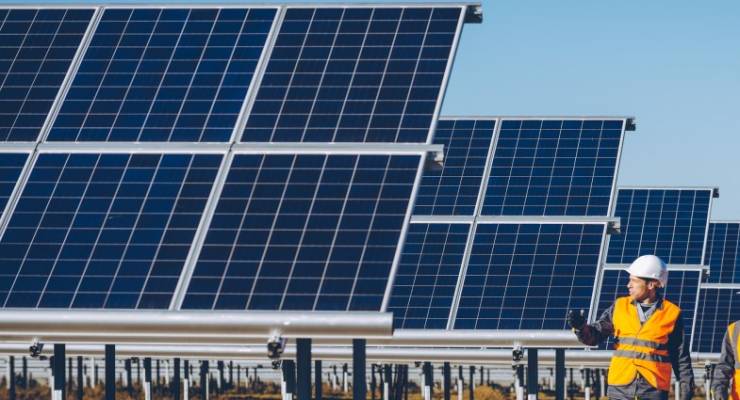
Prime Minister Scott Morrison launched a strident defence of coal on Wednesday, saying the industry was worth $70 billion a year to the economy and vital to many communities around the country.
Asked about the world’s biggest investment fund BlackRock dumping half a billion dollars in coal shares, Morrison said transitioning away from coal could “[pull] the rug from regional communities”.
But experts say most Australians would “hardly notice” if we went coal-free, and that the transition was already well underway.
“Life would go on as usual,” said Paul Burke, an economist working on energy, the environment and transport at the Australian National University’s Crawford School of Public Policy.
“We’re just talking about one input into the economy, and fossil fuels are substitutional for renewables, especially given they are now much cheaper and reliable than before.”
Burke said despite the polarisation of the climate change debate in Australia, the shift away from fossil fuels was not in fact a radical one, and “could happen in a way that most of us would hardly notice”.
So what would the next steps be in terms of weaning ourselves off the black stuff?
More job transition schemes
With a dozen coal-fired power plants already closed in Australia since 2013, according to some figures many local communities are already grappling with the issue of unemployment.
But Burke says the number of people affected is small in economic terms, and that transitional programs are already operating in some states to great success.
The Latrobe Worker Transfer Scheme in Victoria, which is redeploying retrenched Hazelwood power station workers to other sites, has become a world-leader in regional labour adjustment. But more programs will be needed for NSW and Queensland.
“Providing adequate retraining and a safety net for people in those areas is a very important part of planning for this transition.”
Electricity
According to experts, coal is already making a much lower contribution to our electricity mix — down to 60% to from 80% 20 years ago. And Australia’s transport system is increasingly shifting to electricity and batteries.
Dani Alexander, a research principal at the University of Technology Sydney’s Institute for Sustainable Futures, said a grid powered completely by renewables was closer to reality than most people think.
“All the technologies already exist. We don’t need any technological breakthroughs to make it economically viable. If you built a new power station now, it would be renewable. All we’re missing is a comprehensive energy policy.”
Exports
After iron ore, coal is Australia’s biggest export and has propped up the economy for decades.
But Burke says Australia is already primed to export renewable energy to Asian markets.
Iron ore billionaire Andrew “Twiggy” Forrest and tech entrepreneur Mike Cannon-Brookes have invested millions in a $20 billion-plus Sun Cable project set to drive Asia’s transition to cleaner energy.
“This sector could be really ramped up,” Burke said. “There are lots of land and wind resources in the north of Australia, and there is the potential we could be exporting more in terms of energy content and making more revenue from these zero carbon opportunities.”
The take-away?
While the transition away from coal might require political leadership and policy change, it’s happening already.
“The lights will still go on and we will continue to live our lives, and most of us will not even notice,” Burke said.
Will Australia manage to transition away from coal power? Let us know your thoughts by writing to boss@crikey.com.au. Please include your full name to be considered for publication.








On the one hand : agreed! On the other, the world in total (which includes Australians) would not notice if the Libs gave a 100% commitment to coal for the next two decades because emissions from Australia are fractional in the context of the global TOTAL.
As to “coal being (only) one input”, mentioned in the text, there are ancillary relations and multiplier effects that the article has overlooked but in very broad terms it is not going to make a lot of difference whatever the country does to the global problem – which is, in fact, a function of (increasing) population (and energy requirements) that is forecast to touch nine millions in another 15 years; its actually out of control.
Did we not hear from Ros Garnaut late last year, talking a about a book he just published, that if Australia enthusiastically invested in renewables, hydrogen and R&D in those ares, it would be certain that Australia would produce the cheapest energy in the world. Not only would that present massive export opportunities, it would mean that we could re-industrialise Australia. We could be making the cheapest steel and the cheapest aluminium in the world, given our vast resources in the essential raw materials and the ability to produce on-site cheap energy.
No economic experts or commentators have refuted Garnaut’s assertion to my knowledge.
Therefore, the false binary presented by denialists and just plain dumb economists that we have a choice between acting aggressively on reversing carbon emissions and jobs. Garnaut has eloquently exploded that myth. Despite the illogical, ideological inertia of the Coal Parties, this is happening anyway, completely unmanaged by any coherent energy policy.
Imagine how quickly and effectively we could make this transition if government too was on board. We would certainly notice the benefits of leading the world in that transition.
Great sentiments BA, but we know the ‘right’, both liberal and labor versions, won’t allow this to happen. Until there’s much greater public demand and agitation, very little will change. It truly is up to the next generation.
Where would the politicians get their donations from, and their next lucrative job if the coal and gas industry collapses? From the new industry?? This mop will fight it as long as they can. The benefits renewables could bring to manufacturing etc. will be lost to overseas companies, as most Australian start up companies or inventions have done . What was Turnbull’s slogan? There were so many that I can’t remember . “Job and Growth” was one , was there not something about Change and Innovation? Or was that a Morrison’s Marketing catch phrase??
And imagine how many jobs would be in it BA, real jobs and real wealth creation.
Right on BA !
And the transition if done smartly could pull electricity generation largely out of private hands and back into public hands, like it use to be when it was a 1/4 of the price.
A government funded national renewable energy project is what we need. The RBA is calling for infrastructure investment. We can end up carbon free, with cheap electricity which is good for the economy and a ‘green energy’ export powerhouse. We could lead the way, which as one of the worlds biggest CO2 exporters we have moral obligation to do.
Interesting assertion quoted in the article that all the technologies for a 100% renewable powered grid exist, and are economically viable. Would be a good topic for Crikey to explore further, as even in countries with a well defined energy policy, such as Germany, the path to an economically viable 100% renewable powered grid is not clear.
Davo, I suggest that much thinking about future energy generation and consumption is stunted by the assumption that we must maintain a ‘grid’ in similar form to the grid that now constitutes 60% of the cost of electricity you consume. Another chunk of cost is the massive current losses suffered be transmitting electricity over great distances. Renewables, with storage, mean that energy can be produced where it is required without the exorbitant cost of maintaining a grid (that has been designed back-to-front in respect of roof-top solar generation) and writing off mass of energy that is just dissipated by the grid.
Having said that, of course some sort of interconnectivity will probably always be required. But we do not need the grid the way it is currently designed into the future. The reverence for the ‘grid’ is driven purely by those who own them and it surprises me that is rarely questioned.
When I was a kid, there was no grid. Electricity was produced and distributed locally. All tat changed in the 1960s as state governments sought to attract energy-hungry industries like Aluminium production. The gris, as we know it, was never for the benefit of ordinary electricity consumers and we massively subsidies industry in the prices we pay both for grid maintenance and the discounted price enjoyed by industrial consumers.
Renewable energy means we can re-think the whole thing. But so far all the discussion is about how renewables can be integrated into a grid design rot radiate from large generators. Have a look at what has been achieved in Woking in the UK.
“But we do not need the grid the way it is currently designed into the future.”
Again, dead right BA. Smaller in scale and more widely distributed means less likelihood of a whole state grid being taken out by bushfires, floods, etc as well as less transmission losses.
Plus places like SA and WA and regional QLD could set up regional hubs for steel, aluminium and related products where the cheapest power in the world suddenly makes everything viable.
Very little is unachievable with super-cheap energy.
BeenAround suggests that local renewable generators, with storage, could supply isolated microgrids, cut off from the rest of the grid. However any purchasable amount of storage will eventually run out, so requiring fuel-based backup, inevitably gas. Each purportedly independent microgrid would have to be interconnected with the national gas grid. He quotes Woking UK as having achieved a solar-powered microgrid isolated from the UK national grid. Indeed, many true believers quote Woking as an example of 100% renewable power. However if you check Wikipedia, you will find that Central Woking is indeed cut off from the electricity grid, but instead gets most of its electric power from CHP gas generators that get their fuel from the UK gas grid, which remains connected. RE’s reliance on gas is, as I say, routinely glossed over.
Roger. All valid on the basis only that there is no technology change. I think there is enough evidence that technology will constantly improve generation, storage and distribution. Not much in gas. But lots in renewables and storage. A clean and prosperous future is easy to imagine, just on the basis of the evidence we have now. We are just making a mess of getting there.
Problem is how can we export renewables if we cannot supply ourselves ? As Australia has one of the highest electricity costs in the world why don’t we get the cost of electricity down so pensioners can afford it.
Come on Desmond, we all know that our ridiculously high electricity prices bear almost no relation to the cost of producing it. Somehow previous generations were able to build our country very nicely with low cost power. It’s only when privatisation raised it’s ugly head that under-regulated prices skyrocketed, everything else is a smokescreen.
Agreed – as to placing administrative pricing into private (corporate) hands and this is the point as it pertains to exporting renewables.
In any event there exists damn all venture capital in Oz (its all in property and other non-useful assets) and VCE is hardly a model of matriculation from school compared to the standard of (e.g.) Singapore.
Interesting. Three climate-denying posts out of four so far. Clearly the denialist riff-raff has been driven out of more upmarket websites and forced to take their custom to the low-rent dive of Crikey comments.
Exactly what is ‘climate denying’ about my comments? I am advocating a rapid transition to 100% renewable energy.
Me too!